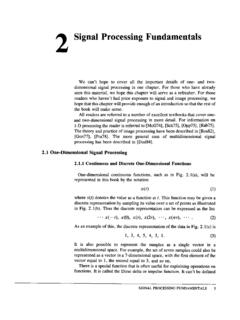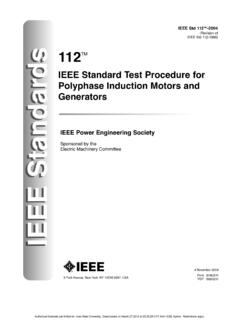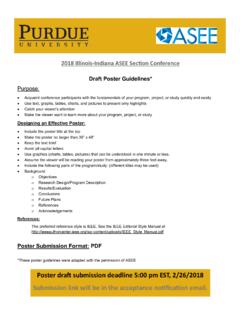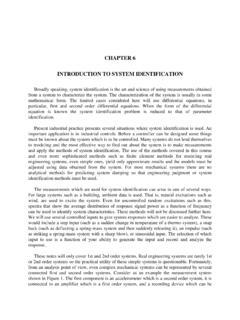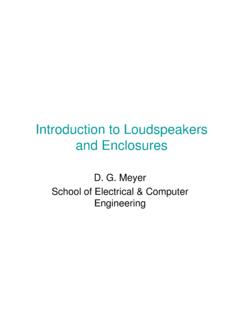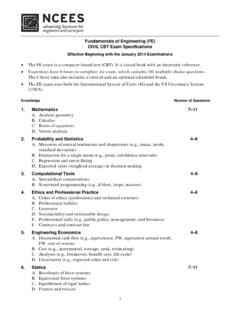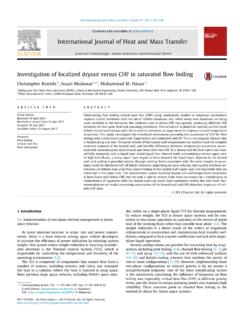Transcription of CE 371- Structural Analysis I Homework #3 Solutions
1 CE 371- Structural Analysis I Homework #3 Solutions 9. Classify each structure shown below a stable or unstable. If stable, determine whether they are statically determinate or statically indeterminate. Explain your reasoning. If statically indeterminate, specify the degree of statical indeterminacy. All structures are planar and movements in the out-of-plane direction are prevented. a) r = 4, n = 1 r > 3n 4 > 3(1) Stable, Statically Indeterminate 1 (Points ) b) r = 10, n = 3 r > 3n 10 > 9 Stable, Statically Indeterminate 1 (Points ) c) r = 7, n = 2 r > 3n 7 > 3(2) Stable, Statically Indeterminate 1 (Points ) d) b= 5, j= 4, r=4 b + r > 2j 5 + 4 > 2(4) 9 > 8 Stable, Statically Indeterminate 1 (Points ) 10.
2 Classify each structure shown below as stable or unstable. If stable, determine whether they are statically determinate or statically indeterminate. Explain your reasoning. If statically indeterminate, specify the degree of statical indeterminacy. All structures are planar and movements in out-of-plane direction are prevented. a) r = 6, n = 2 r = 3n 6 = 3(2) Statically determinate (Points 5) b) r = 6, n = 1 r > 3n 6 > 3(1) Statically Indeterminate 3 (Points 5) 11. Classify each of the structures shown below as stable or unstable. If stable, determine whether statically determinate or statically indeterminate. Explain your reasoning.
3 If indeterminate, specify the degree of statical indeterminacy. All structures are planar and movements out-of-plane direction are prevented. All internal joints are fixed-connected ( rigidly connected). a) r = 15, n = 3 r > 3n 15 > 9 Stable, Statically Indeterminate 6 (Points ) b) r = 26, n = 4 r > 3n 26 > 3(4) Stable, Statically Indeterminate 14 (Points ) c) r = 39, n = 4 r > 3n 39 > 3(4) Stable, Statically Indeterminate 27 (Points ) d) r = 15, n = 3 r > 3n 15 > 3(3) Stable, Statically Indeterminate 6 (Points ) 12. Determine the force in each member of the truss. State if the members are in tension or compression.
4 Assume all members are pin connected. Sol: 2m2m2m5 K N5 K N5 K NGFB y = 1 5 K NAFEDG3mBCA x = 2 0 K N Joint D: FDEFDC5 KN + !FY = 0; FED (3/5) 5 = 0; FED = kN (T) Ans + !FX = 0; FCD 4/5( ) = 0; FCD = kN (C) Ans (Points 2) Joint C: FCB5 kN + !FX = 0; FBC = 0; FBC = kN (C) Ans + !FY = 0; FCE - 5 = 0 FCE = 5 kN (T) Ans (Points 2) Joint G: 20kNFGA15 kNFGF + !FX = 0; FGF 20 = 0; FGF = 20kN (T) Ans + !FY = 0; 15 FGA = 0; FGA = 15kN (T) Ans (Point 1) Joint A: 20kN15 kNFABFAF32 + !FY = 0; 15 FAF (sin ) = 0; FAF = (C) Ans + !
5 FX = 0; - FAB (cos ) +20 = 0 FAB = kN (C) Ans (Points 2) Joint B: 10kN15 kN5 + !FX = 0; - FBE (4/5) + = 0 FBE = (C) Ans + !FY = 0; FFB 5 (3/5) = 0; FFB = (T) Ans (Points 2) Joint F: kN23 FFE18kN345 + !FY = 0; 18 (sin ) FFE (3/5) = 0; FFE = (T) Ans (Point ) 13. Members AB and BC can each support a maximum compressive force of 800 lb, and members AD, DC, and BD can support a maximum tensile force of 2000 lb. If a= 6ft, determine the greatest load P the truss can support. Sol: Assume FAB = 800lb (C) Joint A: P/2 FAD800 lb14A + !
6 FX = 0; - 800 (1/"2) +FAD (4/"17) = 0 FAD = < 1500 lb OK + !FY = 0; P/2 1/"2 (800) + 1/"17 ( ) = 0 P = lb (Points 5) Joint D: lb414 + !FY = 0; - (2) (1/"17) + FDB = 0 FBD = lb < 1500 lb OK Thus, P max = 849 lb Ans (Points 5)
